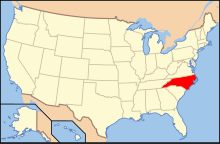
Paleontology in North Carolina refers to paleontological research occurring within or conducted by people from the U.S. state of North Carolina. Fossils are common in North Carolina. According to author Rufus Johnson, "almost every major river and creek east of Interstate 95 has exposures where fossils can be found".[1] The fossil record of North Carolina spans from Eocambrian remains that are 600 million years old, to the Pleistocene 10,000 years ago.
About 600 million years ago, North Carolina was covered by a warm shallow sea that was home to corals, jellyfish, and Pteridinium. This sea remained in place during the early part of the Paleozoic era and was inhabited by a variety of marine life forms, like those that left the trace fossil Skolithos. The later part of the Paleozoic is missing from the local rock record. By the Triassic, North Carolina had a terrestrial environment where the local bodies of freshwater were inhabited by invertebrates and fishes while conifers and cycads grew on land. Dinosaurs and other kinds of prehistoric reptiles lived in the area. The Jurassic is missing from the local rock record, but during the Cretaceous evidence points to a shallow sea covering the state, which was home to creatures like belemnites, and occasionally dinosaur carcasses which had washed out to sea were preserved.
Sea levels began to rise and fall after the Cretaceous, and occasionally marine invertebrates, bony fishes, sharks, and whales were preserved. Cenozoic limestone is common in North Carolina and rich in fossils. The gravel and marl pits of North Carolina are also known for their abundant fossils. Later Cenozoic marine life included the giant shark megalodon. During the later part of the Pleistocene epoch, the sea withdrew from the state, which was then inhabited by mammoths and mastodons.
Early significant discoveries in the state include Cretaceous reptile fossils discovered in the 1850s by state geologist Ebenezar Emmons. During the Civil War, Confederate coal miners uncovered many Triassic fossils. In approximately 1869, the state's first known dinosaur fossils were discovered.